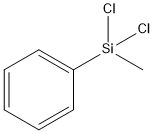디클로로메틸페닐실란 C화학적 특성, 용도, 생산
화학적 성질
Dichloromethylphenylsilane is a flammable,
colorless liquid.
용도
Dichloromethylphenylsilane is used as a monomer (?building block?) in the production of silicone polymers or silicone resins. Silicone polymers may be oils, greases and rubbers. It is also used as an intermediate (starting material) in the production of other organosilicon substances. It is a bifunctional reagent for the preparation of methylphenylsilyl derivatives of diols.
일반 설명
A colorless liquid. Insoluble in water and denser than water. Flash point between 70-140°F. Corrosive to skin and eyes and may be toxic by inhalation and skin absorption. Used to make other chemicals.
반응 프로필
Chlorosilanes, such as Dichloromethylphenylsilane, are compounds in which silicon is bonded to from one to four chlorine atoms with other bonds to hydrogen and/or alkyl groups. Chlorosilanes react with water, moist air, or steam to produce heat and toxic, corrosive fumes of hydrogen chloride. They may also produce flammable gaseous H2. They can serve as chlorination agents. Chlorosilanes react vigorously with both organic and inorganic acids and with bases to generate toxic or flammable gases.
위험도
Flammable, moderate fire risk, reactsstrongly with oxidizing materials. Irritant.
건강위험
The chemical is toxic and is an irritant. Contact may cause burns to the skin and eyes.
화재위험
When heated to decomposition, Dichloromethylphenylsilane emits toxic fumes of chlorine-containing compounds. Flammable/combustible material; may be ignited by heat, sparks, or flames. Vapors may travel to a source of ignition and flash back. Container may explode in heat of fire. Vapor explosion hazard indoors, outdoors or in sewers. Runoff to sewer may create fire or explosion hazard. Fire may produce irritating or poisonous gases. Reacts strongly with oxidizing materials.
Safety Profile
Poison by inhalation,
subcutaneous, and intraperitoneal routes.
Corrosive to eyes, skin, and mucous
membranes. Flammable liquid. When heated
to decomposition it emits toxic fumes of
Cl-. See also CHLOROSILANES.
잠재적 노출
Used in the manufacture of silicones;
and as a chemical intermediate for silicone fluids, resins,
and elastomers
운송 방법
UN2437 Methylphenyldichlorosilane, Hazard
class: 8; Labels: 8-Corrosive material
Purification Methods
Methylphenyl dichlorosilane (dichloro methyl phenylsilane) [149-74-6] M 191.1, b 114 -115o/50mm, 202-205o/atm, d 4 1.17. Purify it by fractionation using an efficient column. It hydrolyses ca ten times more slowly than methyltrichlorosilane and ca sixty times more slowly than phenyltrichlorosilane. [Shaffer & Flanigen J Phys Chem 61 1591 1957, Beilstein 16 III 1211, 16 IV 1517.]
비 호환성
Incompatible with oxidizers (chlorates,
nitrates, peroxides, permanganates, perchlorates, chlorine,
bromine, fluorine, etc.); contact may cause fires or explosions. Keep away from alkaline materials, strong bases,
strong acids, oxoacids, and epoxides. Chlorosilanes react
vigorously with bases and both organic and inorganic acids
generating toxic and/or flammable gases. Chlorosilanes
react with water, moist air, or steam to produce heat and
toxic, corrosive fumes of hydrogen chloride. They may also
produce flammable gaseous hydrogen. Contact with ammonia may form a self-igniting material. Attacks some metals
in the presence of moisture
디클로로메틸페닐실란 준비 용품 및 원자재
원자재
준비 용품







